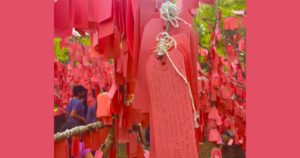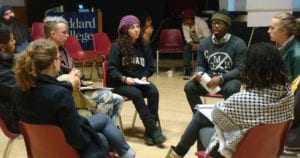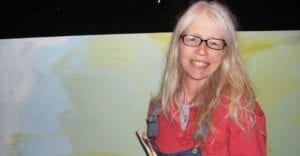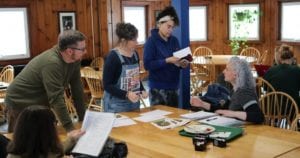 Last night around a campfire, I bonded with our Bedouin guide (عبت) over Arabian Sands. He said the book, which he re-reads often, captures Bedouin culture like a zoom lens (his words) and the changing culture of Arabia like a crystal ball (mine). Thesiger wasn’t the first explorer to cross the Empty Quarter, but he has become arguably the most famous. And he opened up this place for me. Last night I danced in a dishdasha, drank fresh milk from goats, and watched the sunset from towering dunes of powder-like sand.
Last night around a campfire, I bonded with our Bedouin guide (عبت) over Arabian Sands. He said the book, which he re-reads often, captures Bedouin culture like a zoom lens (his words) and the changing culture of Arabia like a crystal ball (mine). Thesiger wasn’t the first explorer to cross the Empty Quarter, but he has become arguably the most famous. And he opened up this place for me. Last night I danced in a dishdasha, drank fresh milk from goats, and watched the sunset from towering dunes of powder-like sand.

Above all other program requirements, I most feared annotations. They were three-page sprints of critical writing that would expose me as an undisciplined, unoriginal phony of a writer. So when Kenny Fries began to read from his legal pad the fifteen books that would fill my next fifteen weeks, I commenced with a visible tremble.

Out of Africa, In Patagonia, A Passage to India joined me for G1—incumbent books on every “best of travel literature” list I’ve ever Googled as an armchair traveler. These selections promised the gratifying stink of an old library book, but also, unfortunately, tiny typewriter fonts and obsolete vernaculars that would pose real obstacles to my poor reading comprehension. Kenny would soon learn I wasn’t too sharp.
Reading Lolita in Tehran, Arabian Sands, and Heart of Darkness went into my luggage the following term, books pulled from a seemingly slender shelf of great “travel writers,” authors that represent the clout I could never achieve. I would never be able to understand how they wrangle such philosophically dense observations and sensory details to touch generations of curious readers.
Required reading threatens me. I tell myself that everyone fears being identified as unintelligent or an imposter within their field, especially people whose work makes their inner thoughts public.
Reading on the Move
Upon leaving my G1 residency, I flew directly to Sarajevo, Bosnia & Herzegovina to begin another trimester of teaching international students, knowing I was about to be less “stationary” with my new job title. Being a Curriculum Developer at a peripatetic school would mean immersing in eight of our school’s future locations in short spurts to make hundreds of documents and use all my creative, researching, networking, and brainstorming power. When I finished G1 in our third trimester location of Italy, I left an apartment that would come to represent the most settled I would be for the next year and a half.

When my G2 residency came around, I was an old pro, planning packet submissions around international flight times and coordinating my required reads based on their relevance to the destinations on my itinerary: Rizzuto and Richie while in Japan, Iyer’s short stories from South Asia while visiting Mumbai, Campbell’s Heart of Darkness while traversing Southern Africa in a kombi van.
In matching books to my destinations, I discovered something that doesn’t seem so remarkable in hindsight but at the time was enchanting and empowering: reading a book while immersed in its setting makes its world come alive around you. Of course it does. Who wouldn’t prefer to read Out of Africa while sitting on Isak Dinesen’s porch in Nairobi? Or take in the Tochāl mountains and the call to prayer in the capital of Iran while poring over Reading Lolita in Tehran?
When Settings Come Alive
Many years before Goddard, I had similar experiences of that “reading magic,” and they became favorite trip anecdotes. A street performer once leaned into my shoulder as he keyed the theme from The Godfather into his accordian. He pulled my attention from the words of Mario Puzo and left me with a distinct feeling of awe. From this same spot on the edge of the Santo Spirito fountain, I read The Agony and the Ecstasy. With a turn of the head, I could see the church doors from which Michelangelo once smuggled a cadaver (for anatomy research, of course).
That reading magic—the kind felt by being an eyewitness to the world of a book—was able to replicate for me the visceral power of a movie. I could read a book and feel like I was there, because in an obvious way, I was. I could easily pretend that mafiosos were rounding the corner to whack a guy with a cannoli. My reading focus seemed to increase tenfold.
Throughout this abnormal and unreal streak of traveling I’ve been on for the past decade—backpacking away my savings, living in a Fijian village, working for travel companies, and teaching at a nomadic school—reading magic has become a destination of sorts that I aim to visit with each spare moment. And though I realize it’s a tremendous privilege to be able to visit book settings as varied and unique as the Karakorum mountains of Kashmir or the edge of the Seto Inland Sea, the already sky-high elation of visiting those places grows exponentially if a book can show me another reality than what I experience in present time.
Being a Tourist vs. an Eyewitness
I’ve tried to differentiate between the act of reading about the world in which I’m immersed and visiting the world about which I once fantasized. It’s the difference between being a tourist and an eyewitness (I wouldn’t dare drum up that eternal identity crisis of travelers). In true tourist fashion, I sought the romantic setting of a book, camera dangling from my neck:
Last March, my advisor suggested a flaky old book called The Sheltering Sky. I followed Kit as she traveled through old Morocco and Algeria, lost her man, got nutty, and ultimately took to the desert with a camel caravan. Last month, I made it to the edge of the Moroccan Sahara for 12 hours and felt that magic of popping into the world of a book. I tried not to lose myself like Kit, but that silence was colossal. Thanks for showing me a new part of the world, Mr. Bowles.
And then there are times—in Italy, Botswana, Hiroshima, Mumbai—when I become an eyewitness to the worlds of my required reads. Words jump like fleas from the page. Oftentimes I want to read aloud to nearby strangers the words that match so perfectly with our shared experience. Oh, how I’ve ached to share with my fellow chai sippers of Bandra, “The streets of India are swollen with an embarrassment of riches, a richness of embarrassments. And it is on the streets that millions live, make love, defecate, and die,” (Iyer, 259).
Being present in this setting inspired the most successful and technical annotation I wrote all year.

I’ve never been more intimidated by a writer than I was at that tea stand in Mumbai, hearing the sizzles and chatter and honking and clamour that Pico Iyer did and knowing it would take me years to reach the perfection of his descriptions in Video Night in Kathmandu.
Airplane or Armchair Travelers Alike
These opportunities are unique, and I know that I am part of the 1% of 1% of humans on this planet that gets to visit these worlds that authors make accessible to the masses. Traveling abroad has helped me collect millions of little stories; my mental “writing database” overfloweth. But this phenomenon of being a “book eyewitness or tourist” is accessible to everyone, location irrelevant.
As an educator, I preach the benefits of place-based education, so I find it ironic that it took me so long to recognize the obvious utility of place-based reading, for struggling and proficient readers alike. Place can be as close as Walden pond or as remote as Bowles’ Algerian oases.
Be warned: place-based reading can intimidate, but it also transforms any inhabitable place into a classroom (quite satisfying for low-residency students, I say). It can increase focus. It can maximize the force and the beauty of language. It can instruct self-proclaimed bad readers to be present and struggling writers to build settings that move and breathe. At least, it has for me. Worldbuilding has never been so fun.
Iyer, Pico. Video Night in Kathmandu: And Other Reports from the Not-so-far East. New York: Knopf,
1988. Print.
Originally from Indiana, Lindsay Clark is a nomadic educator, photographer, filmmaker, and writer. Since 2011, she’s developed curriculum and media content for THINK Global School, the world’s first international school that locates in four different countries per year. Her blog is Nomadderwhere.com.
All images copyrighted by Lindsay Clark, Nomadderwhere.com 2008-2017.







